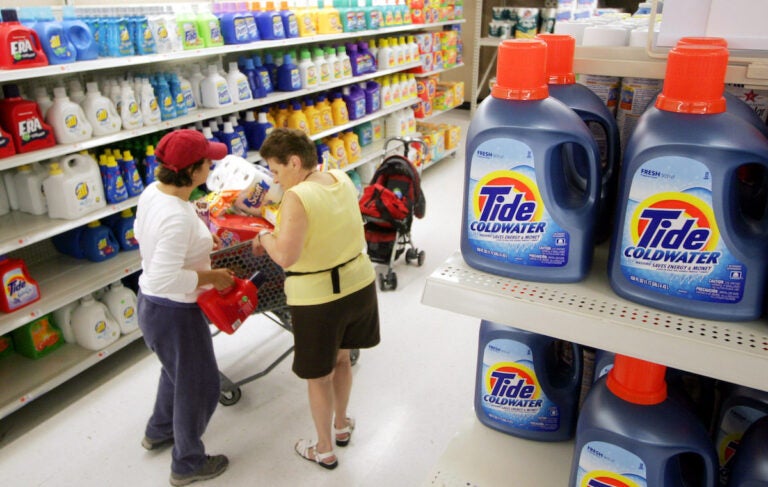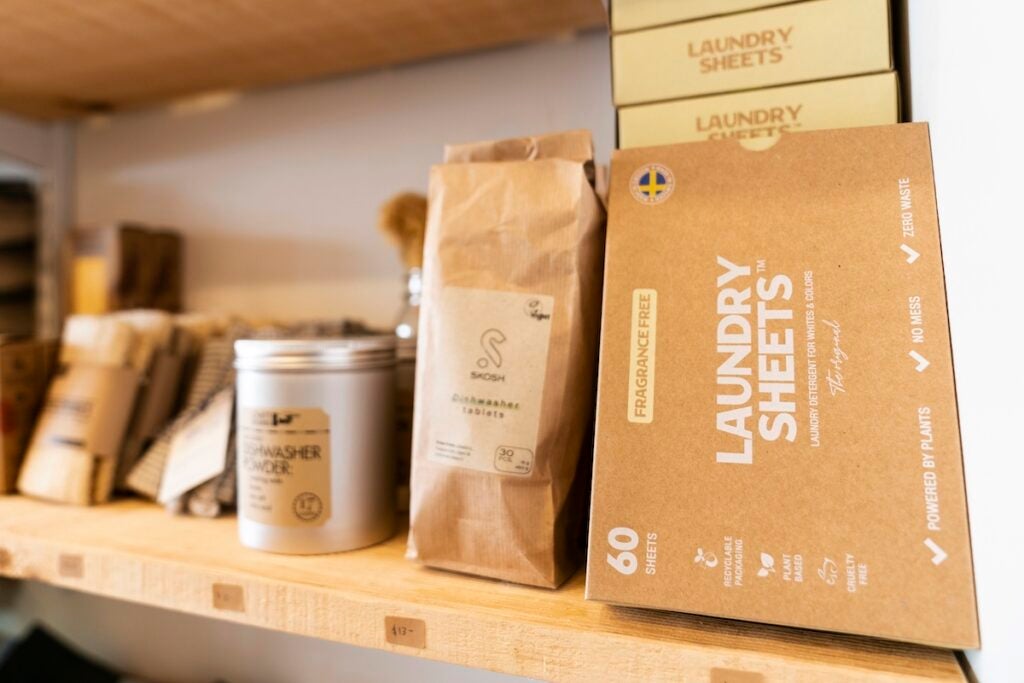From cold washing to detergent sheets: greener options for laundry
How we do our laundry has gotten an eco-friendly makeover — but do greener options impact the cleaning power of our wash cycle?
Listen 10:53
Shoppers pass a display of Procter & Gamble's Tide detergent at a Wal-Mart in White Plains, N.Y. July 21, 2006. (AP Photo/Mark Lennihan)
This story is from The Pulse, a weekly health and science podcast.
Find it on Apple Podcasts, Spotify, or wherever you get your podcasts.
Doing laundry is a frequent chore for many of us. Industry surveys report that half of Americans do seven or more loads of laundry per week. So how we wash our clothes ends up having a major impact on the environment.
When it comes to detergent, liquid is king in the U.S., which means heavy plastic jugs that take a lot of fuel to transport and result in tons of plastic trash. Liquids overtook powder as the preferred choice about 20 years ago — but the decline of powdered detergents started much sooner.
How liquid detergents won over the hearts of consumers
When chemist Curtis Schwartz started his career in 1987, working on consumer products, powder was still the detergent of choice. It was sold in big boxes, and it contained phosphates. Schwartz says they worked like a charm.
“The world was beautiful — very good cleaning from these high alkalinity phosphate detergents.”
He says the phosphates dissolved easily and were great at getting out stains, but they were also ending up in streams and lakes. Since algae need phosphorus to grow, the runoff led to massive algae growth — choking out waterways. Eventually, phosphates were banned, and that impacted detergent formulations.
Schwartz says without phosphates, powder detergents didn’t dissolve as well, and they weren’t as effective. Schwartz says you were supposed to put the powder in the washer first, on the bottom, to give it the best chance to dissolve, but people didn’t always follow the directions.
“Who listens to directions, right? You put your laundry in first, you overstuff it, you put the powder in, it gets into the folds, and it hardly sees any agitation,” said Schwartz. “Maybe even just one percent of the time, you ended up with residue. That’s thousands of unsatisfied customers. But that’s enough to have a lot of complaints.”
Making laundry matters worse, there was pressure to use less water, to make the wash cycle more energy efficient. And a new player was rising to prominence in the detergent market: Wisk.
Wisk ran a very successful, albeit pretty annoying, ad campaign for its liquid detergent, the first to hit the market. In various iterations, the commercial showed a woman putting away clean laundry when suddenly a chorus erupts in a chant of “ring around the collar, ring around the collar,” pointing out that the shirt in her hands was not truly clean. The ad claimed that Wisk had superior cleaning power because the liquid detergent could seep into fabrics and start working before the wash cycle had even begun.
Making liquids work
Soon, the pressure was on for other detergent makers to develop more liquid options. Schwartz remembers the challenges of making the formulation work, since all the ingredients had to be compatible now.
Subscribe to The Pulse
“It can’t turn into molasses on a cold day if you leave it in your car and it’s cold out. It can’t face separate like salad dressing. Over time it has to be shelf stable.”
As a quick side note: This issue, Schwartz says, also explains the design of the laundry pods that have become very popular, that usually have three different compartments in three different colors.
“They have three different compartments and that’s to separate largely incompatible ingredients that otherwise you would have to have a solvent to dissolve to keep it uniform,” he said.
More and more liquid options came on the market, and by the early 2000s, they had taken over as the preferred choice, with big environmental impacts.
A new way to do the wash
“Seven hundred million jugs of laundry detergent are thrown away every single year in the United States alone,” said Reid Edgar, owner of a company called Spot Detergent.
It was that number that got Edgar into the detergent business, with the hope of creating an alternative that is lighter and creates much less waste.
His company has developed a detergent in a sheet form, one of several on the market. It looks like a dryer sheet, but thicker. Edgar says the sheets dissolve more readily than powder. The boxes are light and take up very little space — so it’s more environmentally friendly on those accounts. But the Spot boxes are not designed to look like a “green” product, they are bright and cheerful, more like any other cleaning product. Edgar says that’s intentional to get all kinds of consumers to give these sheets a shot, not just environmentally conscious people.

“We want to make it as easy as possible for the person to try it that one time,” said Edgar. “When you put it in the washing machine, it’s doing the exact same thing. It has to work well, otherwise people are going back to plastic.”
Going cold is a hot topic
In addition to reducing waste, detergent makers are trying to reduce their environmental footprint with another initiative: Convincing consumers to wash their laundry cold more frequently. Celebrities like rapper and actor Ice-T and wrestler Stone Cold Steve Austin spread the word in a Tide commercial, where they are cold-calling (get it?) consumers to tell them that cold water works just as well as using warm or hot water for most loads.
For detergent manufacturers, the call for cold water has meant yet more changes in formulations, specifically in terms of the surfactants, the “it factor” in laundry soaps.
“It’s a molecule that’s going to help hydrophobic oily-dirt-type substances get carried away by the water. It has an end that is attracted to water and an end that is attracted to oil and lets those two mix,” explained Craig Bettenhausen, senior editor at Chemical and Engineering News, who covers consumer chemicals.
Surfactants chip away at the stains, and then more of these molecules form a sphere around the dirt particles to carry them away with the wash water. But when you bring down the temperature, that reaction slows down.
“Any chemical reaction slows down in colder temperatures,” said Bettenhausen, “including the reactions involved in getting a shirt clean. But surfactant chemistry slows down more sharply with temperature than, for example, enzyme chemistry. So one of the things they’re doing to make these cold-water formulations work is they’re leaning more heavily on enzymes.”
Enzymes are proteins that act as a catalyst. They speed up chemical reactions.
“So those are the molecules that are actually breaking apart the starch or the oil or the protein at a molecular level, literally ripping the molecules apart, so that they are easier for the detergent to pick up,” he said.
But when it comes to odors, cold washing can be a bit of a challenge, says Bettenhausen.
“The odors get worse as your laundry ages, because those are molecules fermenting on your shirt, he said. So that ends up with a complex soup of biological molecules … because these microbes … will grow on your old laundry, they’ll die, the cells will burst.”
Enzymes can come to the rescue here, too, says Bettenhausen. “These enzymes can really break up those complicated biomolecules, that can help a lot.”
But cold washing is not for everything. Bettenhausen says if you have something that is really dirty or smelly — warm or hot water will work better.
“The heat is always going to help and even if you take a cold-water detergent and use it in hot water, it’s going to be more effective than it is in cold water, no denying that it’s just that the cold water is enough for most things.”
And that’s the main message from cold water washing proponents: Even if you go from hot to cold or warm to cold for most of your laundry — it will be a big savings in terms of your energy cost and your carbon footprint and let’s face it, a lot of our laundry is just not that dirty. “For most loads, most cycles, we’re over washing” said Bettenhause. “We’re doing more than we have to, we’re cranking it up to 11. We can get just as good of a clean with less intensity”.”
WHYY is your source for fact-based, in-depth journalism and information. As a nonprofit organization, we rely on financial support from readers like you. Please give today.







